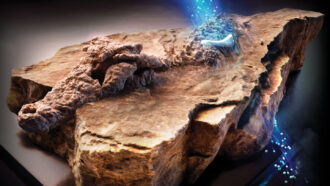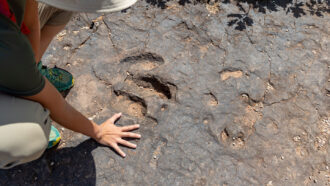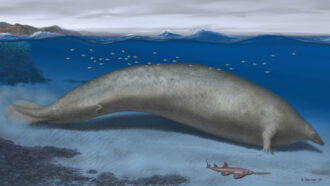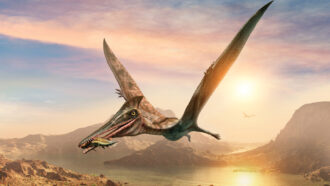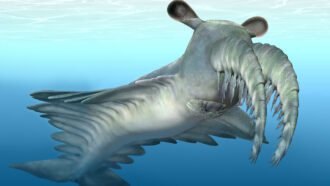An ancient hippo-sized reptile may have been a speedy beast
Anteosaurus’ skull suggests it may have moved fast for its day
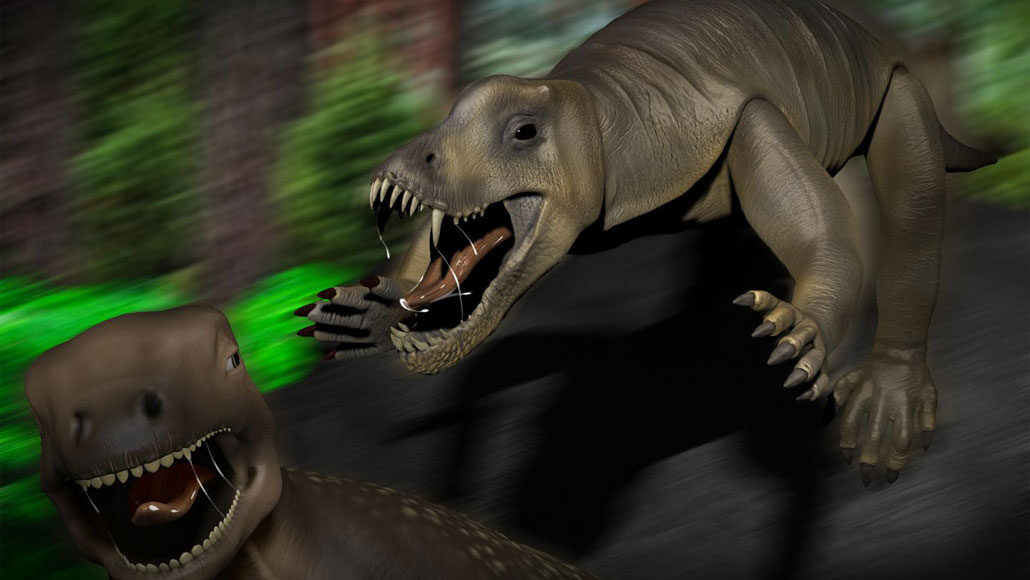
With fangs the size of bananas and capable of crushing bones, anteosaurs (one illustrated chasing a Moschognathus) reigned as top predators before the advent of dinosaurs.
Alex Bernardini
Some 260 million years ago, dinosaurs had not yet evolved. Other reptiles reigned as land’s largest predators. These anteosaurs were bone crushers. A new analysis now suggests these hefty beasts may have been relatively speedy.
“This contradicts what we knew about anteosaurs before,” says Ashley Kruger. He’s a paleontologist. He works at the Swedish Museum of Natural History in Stockholm. These beasts were about as big as today’s hippos or rhinos. Based on that size, researchers had pegged them as sluggish. They had assumed the animals waited to ambush prey. The skull of an Anteosaurus magnificus now seems to tell a different story.
Kruger was part of a team from Europe and Africa. They started with CT scans of segments from a skull. The fossils came from a juvenile that had been dug up in South Africa. The team digitally reconstructed its long, bumpy noggin. It appeared to have been adapted for head-butting. And the animal’s inner ears dwarfed those of its peer predators, they found. Bony tubes in those ears would have helped with balance. Their shape also suggests these reptiles had a rather large brain region. It could have coordinated motion while spying prey. The researchers shared these conclusions February 18 in Acta Palaeontologica Polonica.
The team also compared the skull of this A. magnificus with that of a head-butting relative. It’s called Moschognathus whaitsi. The skull of this herbivore slopes downward. In contrast, the anteosaur appears to have held its head more level. That would allow it to more easily scan its environment. All of these findings suggest that Anteosaurus was an agile hunter, Kruger says. It could move quickly while tracking prey.
These conclusions are reasonable, says Z. Jack Tseng. However, he adds, this team has not proven anteosaurs were fleet-footed. They found no “smoking gun,” says this paleontologist. He works at the University of California, Berkeley. Kruger’s group drew on comparisons with the inner ears of modern mammals, he notes. Those animals are only distant relatives of the early reptiles that include anteosaurs. But even in today’s beasts, scientists don’t know exactly how inner ears affect different types of motion. More data from the rest of the skeleton are needed, Tseng says, to better understand how these animals moved.
Much of what’s known about Anteosaurus beyond the skull comes from its close relatives, points out Christian Kammerer. He is a paleontologist at the North Carolina Museum of Natural Sciences in Raleigh. Anteosaurus probably had leaner limbs than related plant eaters. So it seems this animal could have been capable of sprints, he says.
Right now, Kammerer says, it’s hard to know whether this reptile was an ambush or pursuit predator. In fact, he adds, it is “perhaps unknowable.” Animals at that time were quite different from modern ones. The swift herbivores of the Serengeti in Africa today would outpace Anteosaurus. But perhaps anteosaurs chased in a world where big plant-munchers moved like tortoises.


